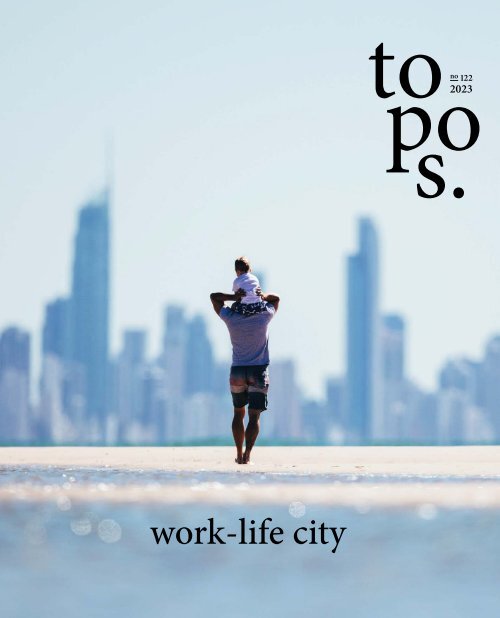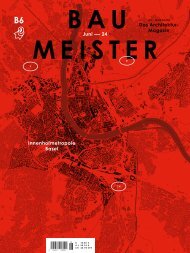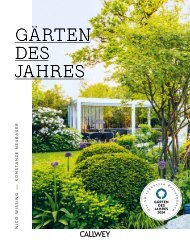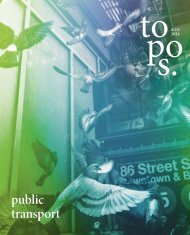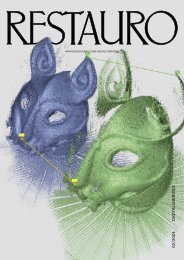topos 122
work - life - city
work - life - city
- No tags were found...
You also want an ePaper? Increase the reach of your titles
YUMPU automatically turns print PDFs into web optimized ePapers that Google loves.
no <strong>122</strong><br />
2023<br />
to po s.<br />
work-life city
COVER<br />
PHOTO: City of Gold Coast<br />
Less work, but more time for family, friends<br />
and leisure. These days, many people look for a<br />
good balance between work and life. Or in<br />
other words: a better quality of life all around.<br />
In this <strong>topos</strong> we discuss how metropolitan<br />
areas can support the work-life balance of<br />
their residents – and why this is also a key<br />
responsibility of the metropolis.<br />
Mindfulness, meditation, social detox – finding<br />
a balance in everyday life, between work, family,<br />
friends, sports and smartphone, seems to have<br />
become the most important asset for many – especially<br />
younger – people. Several studies confirm<br />
that a supposedly "good" work-life balance<br />
is now actually particularly important for many<br />
people – for example, more important than their<br />
salary. The new target of self-optimization, malicious<br />
tongues might think.<br />
Less work, but more time for family, friends and<br />
leisure. Or in other words: a better quality of life<br />
all around. Most people probably wouldn't say<br />
'no' to that. If that's possible. Because ultimately,<br />
it is a luxury, the balance between life and work.<br />
Who can afford to work a four-day week, but<br />
only get paid for four days? Very few. Work-life<br />
balance is reserved for an elite group. To which I<br />
must count myself. And you, presumably, too.<br />
Even if only about ten to 20 percent of the<br />
world's population can afford to work actively<br />
on their work-life balance, it is already visible everywhere<br />
in our cities. You tell me: Have there<br />
ever been more yoga studios? Life coaches? Feel<br />
good managers? I would say 'no.'<br />
Nonetheless, cities or urban structures can also<br />
help support the daily balance of all city dwellers,<br />
support their quality of life. Regardless of their<br />
income or wealth. This is precisely what must be<br />
the goal of public welfare-oriented urban planning.<br />
And it is also necessary: According to a<br />
Swedish study of 4.4 million people, residents of<br />
densely populated areas – in contrast to people in<br />
rural areas – have a 68 to 77 percent higher risk of<br />
developing a psychosomatic illness and a 12 to 20<br />
percent higher risk of depression. The research<br />
field of neurourban studies is still quite young<br />
and small, but we already know: cities make people<br />
sick. Physically and mentally.<br />
So how can metropolitan areas support the<br />
work-life balance of their residents (and by that I<br />
mean everyone)? We discuss no less than that in<br />
this <strong>topos</strong> issue. Based on our research, we have<br />
defined seven topics that are crucial for a better<br />
quality of life in a city: one's income (dollar bill<br />
y'all), the available recreational facilities (yes,<br />
there are some things money can't buy), whether<br />
a city is family-friendly (or rather what that actually<br />
means), whether it offers social security (and<br />
why everyone suffers from FOMO), how to get<br />
around (bye bye traffic jams), how to live (hi<br />
one-bedroom apartment) and finally what the<br />
opportunities for work are now after the pandemic<br />
(did you know that Australia is known to<br />
be the best place for digital nomads?). Our objective<br />
is to analyze what is important in our cities,<br />
but above all what is possible.<br />
Of course, when it comes to work-life balance,<br />
each of us needs something different. Even if cities<br />
have long since started the race for the highest<br />
quality of life or work-life balance. With such a<br />
personal topic, there can be no general easy solutions.<br />
But to get an understanding of how diverse<br />
these life realities can be, we introduce you to<br />
three extraordinary people and their perspectives<br />
on living and working in a city. Enjoy reading.<br />
TOPOS E-PAPER: AVAIL-<br />
ABLE FOR YOUR DESKTOP<br />
For more information visit:<br />
www.<strong>topos</strong>magazine.com/epaper<br />
THERESA RAMISCH<br />
Editor-in-Chief<br />
t.ramisch@georg-media.de<br />
<strong>topos</strong> <strong>122</strong> 005
CONTENTS<br />
OPINION<br />
Page 9<br />
THE BIG PICTURE<br />
Page 10<br />
CURATED PRODUCTS<br />
Page 102<br />
REFERENCE<br />
Page 106<br />
METROPOLIS EXPLAINED<br />
Page 12<br />
URBAN PIONEERS<br />
Page 14<br />
THE SOLUTION BUILDERS<br />
Page 76<br />
Photos: Mary Grace Long Photography, Rob Potter via Unsplash<br />
AND THE WINNER IS… OSLO<br />
The top work-life cities in the world<br />
Page 22<br />
INCOME AND HEALTH<br />
The impact of income on life expectancy<br />
Page 24<br />
LOOKING FOR YOUR HAPPY PLACE?<br />
The world's happiest countries<br />
Page 28<br />
URBAN GAMES<br />
How Paris prepares for Olympia<br />
Page 36<br />
THE OPEN-HEARTED<br />
A portrait of child counsellor Shanti Hetz<br />
Page 38<br />
BABY STEPS<br />
Improving major aspects of children’s lives<br />
Page 44<br />
A CHILD-FRIENDLY CITY<br />
What would it look like?<br />
Page 46<br />
THE PRIVILEGE OF MISSING OUT<br />
FOMO has become a serious urban issue<br />
Page 52<br />
THE PAID ACTIVIST<br />
A portrait of climate expert Andrea Zafra<br />
Page 60<br />
RACE AND PLACE<br />
The California Healthy Places Index<br />
Page 66<br />
COMMUTING AND MENTAL HEALTH<br />
It's the way we travel we should consider<br />
Page 68<br />
LONG LIVE THE BIKE<br />
Cycling is not only hip and<br />
good for the climate<br />
Page 74<br />
SAFER CITIES<br />
What makes a city safe?<br />
Page 82<br />
DARING UTOPIA<br />
What we need to do now – a commentary.<br />
Page 84<br />
SKY HIGH STANDARDS<br />
San Francisco’s Harvey Milk Terminal 1<br />
Page 88<br />
WORKING FROM HOME<br />
How it changed us forever<br />
Page 90<br />
NO HOME BUT THE BEST HOME<br />
The best countries for a digital nomad life<br />
Page 98<br />
CONTRIBUTORS<br />
Page 100<br />
CITY GAME CHANGERS<br />
Page 112<br />
IMPRINT<br />
Page 113<br />
EDGE CITY<br />
Page 114<br />
THE BENEFITS OF SPORTS AND<br />
OUTDOOR SPACES IN THE CITY<br />
Page 30<br />
<strong>topos</strong> <strong>122</strong> 007
THE BIG PICTURE<br />
Swim City<br />
Forget the Hamptons, Bondi Beach, the Florida Keys, etc. Summer is best spent where? In Switzerland.<br />
Strangely enough. Here, an urban trend has manifested itself in recent years: river swimming. While Berlin,<br />
London and Paris were still struggling with the implementation of their river pools, people in Basel, Bern,<br />
Geneva or, as pictured, the city of Zurich, were already jumping into the city river at all times of the day -<br />
without paying any entrance fees, of course. According to the organizers of the exhibition "Swim City" at the<br />
S AM Swiss Architecture Museum, river swimming is possible primarily because of Switzerland's pragmatic<br />
legal approach to risk. The difference: In contrast to many other countries, swimming in moving water is<br />
legally permitted in this country. At the same time, however, no one in Switzerland denies that swimming in<br />
flowing water is risky. Information about the requirements and dangers is provided in many places. The<br />
population is trusted to realistically assess risks and their own swimming abilities. Switzerland is thus living<br />
a culture of democratized risk, creating new public space free of consumption – and pure quality of life.<br />
TEXT: THERESA RAMISCH<br />
010 <strong>topos</strong> <strong>122</strong>
The Big<br />
Picture<br />
Photo: Lucía de Mosteyrín<br />
<strong>topos</strong> <strong>122</strong> 011
METROPOLIS EXPLAINED: STEVEN KRETZMANN<br />
Capetown<br />
The mountain, with its sheer cliffs rising<br />
above the white sand and turquoise water of<br />
Cape Town’s beaches, makes the city unique<br />
in providing a 25,000 hectare national park in<br />
its midst. Within minutes, you can travel from<br />
a cosmopolitan city centre of art galleries,<br />
bars, theatres, renowned restaurants, and<br />
buzzing coffee shops, to step onto a trail leading<br />
into a wilderness housing the most diverse<br />
floral kingdom on the planet outside of the<br />
tropics. Being only about 350 years old, Cape<br />
Town lacks the grand architecture of European<br />
and Asian cities, but it is where the graceful<br />
Cape Dutch architecture was born, and the<br />
city retains many of its Georgian and Victorian<br />
buildings, particularly along Long Street,<br />
its nightlife strip. Contemporary architectural<br />
styles are also evident, particularly at private<br />
homes along the Atlantic seaboard, which is<br />
some of the most expensive real estate on the<br />
continent. It is a cosmopolitan city with a cutting<br />
edge cultural scene as evidenced in the<br />
Zeitz Museum of Contemporary African Art<br />
designed by the acclaimed Thomas Heatherwick,<br />
the Baxter Theatre with its international<br />
touring shows, outdoor concerts by in the<br />
famed Kirstenbosch Botanical Gardens, and<br />
vibrant nightlife. It is also a city of extreme<br />
contrasts and contestation. It has villas worth<br />
more than 11 million Euros while hundreds<br />
of thousands of residents live in corrugated<br />
iron shacks with inadequate access to water<br />
and sanitation: the injustices of the past continually<br />
rub against the progress of the present.<br />
The first thing the Dutch did when they<br />
set up a refreshment station at Table Bay was<br />
build a castle – still standing and in use by the<br />
national defence force today – and violently<br />
dispossess the native Khoi herders of their<br />
traditional grazing lands. This was the genesis<br />
of the colonisation of southern Africa later<br />
perfected by the British. The Khoi, along with<br />
the slaves imported from Africa, Madagascar,<br />
Malaysia, and Indonesia, were pushed to the<br />
margins of society. This marginalisation of<br />
people of colour was further entrenched<br />
under apartheid, which rebuilt the city along<br />
racial lines. The apartheid spatial planning<br />
That Cape Town is one of<br />
the most beautiful cities<br />
in the world is not contested.<br />
With Table Mountain<br />
as a backdrop and<br />
encircled by the mountain’s<br />
flanks, the city<br />
bowl, in the middle of<br />
which are the sprawling<br />
public gardens originally<br />
established by the Dutch<br />
East India Company to<br />
supply fresh produce to<br />
their ships on the way to<br />
the East Indies, looks out<br />
across the harbour,<br />
northwards toward the<br />
rest of Africa.<br />
STEVE KRETZMANN has worked as a journalist for 23<br />
years, having founded the news agency West Cape<br />
News in 2006, mentoring young adults to provide previously<br />
overlooked stories of Cape Town and surrounds<br />
to the South African, and international press.<br />
The growth of free online news led to West Cape News<br />
having to close offices in 2013, with Steve continuing<br />
as a freelancer, covering social justice, the environment,<br />
and, through his site The Critter, the arts. He is<br />
also editor of monthly community newspaper Mother<br />
City News. After growing up in Johannesburg, he first<br />
moved to Cape Town in 1992, later studying at Rhodes<br />
University in Makhanda.<br />
still dogs the city even as global corporations<br />
oversee a new colonisation: Amazon is controversially<br />
building its new African headquarters<br />
on the site of original colonial dispossession<br />
along the Liesbeek River bank, a<br />
development supported by city authorities<br />
but mired in litigation brought by the descendent<br />
of the Khoi who lived at the foot of the<br />
mountain before the Dutch East India Company<br />
– the original global corporation –<br />
arrived. Economic segregation has replaced<br />
racial segregation. The working class, who are<br />
predominantly people of colour, still live far<br />
from the opportunities of the city centre, in<br />
crowded townships on the sandy wastelands<br />
that form the isthmus between Table Mountain<br />
and the rest of the continent. The city<br />
bowl and wooded mountain slopes remain<br />
reserved for the rich, who remain predominantly<br />
white and increasingly international.<br />
Thus for the privileged, Cape Town is an idyllic<br />
city with all the convenience of fast internet<br />
and world class infrastructure, with culture<br />
and work opportunities on the doorstep<br />
and untrammelled wilderness in the backyard.<br />
But with an official unemployment rate<br />
at 29,5 percent and an average annual household<br />
income of about 3,000 Euros, this is not<br />
the experience of the majority. It is thus not<br />
surprising that a getkisi survey of 100 cities<br />
with the best work-life balance for 2022<br />
placed Cape Town last. Most residents have<br />
to rise at dawn and spend an hour or more on<br />
dysfunctional and unsafe public transport to<br />
get to work or school, returning only after<br />
dark, with visits to the beach or the mountain<br />
confined to a handful of special days during<br />
the year. Yet, Cape Town is the most functional<br />
and financially healthy city in South Africa,<br />
predicted to double in population to about<br />
10 million within a generation. With a politically<br />
stable administration, policy geared to<br />
providing affordable housing close to work<br />
opportunities and fixing the failing public<br />
transport system, Cape Town is starting to<br />
dismantle its divisive planning history and<br />
hopefully becoming a city that can be<br />
enjoyed by all who live in it.<br />
012 <strong>topos</strong> <strong>122</strong>
Metropolis<br />
explained<br />
Map: openstreetmap.org<br />
<strong>topos</strong> <strong>122</strong> 013
URBAN PIONEERS: MAGDALENA STEINHAUSER<br />
Parkour Generations<br />
Leaping down entire flights of stairs, climbing<br />
walls, vaulting over balustrades – what seems<br />
daunting or just plain dangerous to most of us<br />
is exactly what those practicing parkour love<br />
doing. This strictly non-competitive sport has<br />
the aim of moving efficiently across any terrain<br />
and surrounding using only your own body.<br />
Those practicing the sport, which was originally<br />
termed “Art du Deplacement”, seek to become<br />
physically, mentally, and ethically strong. It is a<br />
sport that does not simply train the body. “Traceurs”<br />
aim to be able to rely on themselves, be<br />
adaptable, protect the environment, be disciplined,<br />
value friendships and community, and<br />
be of service to others.<br />
“Public spaces are there to be used, embraced,<br />
explored – both for kids and adults, and nothing<br />
does that better than parkour.” That is the<br />
motivation for Parkour Generations – one of<br />
the pioneer organizations in the sport. The<br />
internationally active professional parkour<br />
organization with headquarters in London, UK<br />
was founded in 2005. Over fifteen years later<br />
they have received several awards for their work<br />
and have established gyms in multiple cities<br />
across the UK as well as the U.S., South Korea,<br />
and Brazil. They have become the first and largest<br />
parkour teaching and certification framework<br />
in the world.<br />
“Urban living has typically reduced most modern<br />
people's movement throughout their day<br />
and has certainly reduced the variety of movement,<br />
and that's a huge problem and one that is<br />
heavily responsible for the many common<br />
health issues we see in our populations.” To<br />
tackle this issue for people from all walks of life,<br />
they create spaces where children, teens, adults,<br />
people with disabilities, and the elderly can all<br />
find their peers. They are convinced that “the<br />
human body is the perfect adaptive movement<br />
organism, literally evolved for practical movement<br />
over almost any terrain. It wants to move,<br />
and the more it does so the fitter, stronger and<br />
healthier it will be, and the longer it will last.“<br />
There could hardly be a more straightforward<br />
way to engage with your urban environment, to<br />
get to know the very materials utilized in building<br />
a city, and to get to evolve alongside it. Parkour<br />
is about learning to be as resilient as your<br />
environment. It encourages a shift in how you<br />
view your surroundings and to find playful<br />
solutions to any obstacle.<br />
Outsiders might be somewhat skeptical of a<br />
sport that initially seems mainly to be encouraging<br />
people to smash their bodies into concrete<br />
walls. But in parkour, the “traceur’s” safety<br />
is always at the forefront. Instead of trying to<br />
ace the craziest tricks, the aim is self-mastery<br />
and self-knowledge. It demands full focus and<br />
forces you to concentrate entirely on yourself.<br />
This teaches those practicing the sport to know<br />
their limits, to respect them, and to playfully<br />
work on expanding them.<br />
Just like the sport itself, Parkour Generations<br />
want to have a positive impact on urban communities.<br />
Through multiple outreach programs<br />
and initiatives for women and people of different<br />
backgrounds and abilities, they “help people<br />
reclaim their movement and learn to apply<br />
their physicality within their urban environment<br />
– not just taking the train to get to a gym<br />
but using the city as your gym!” They run cleanup<br />
events, offer training for the military and<br />
police, and give presentations to international<br />
governing bodies.<br />
Seeking to create more urban spaces that<br />
encourage a playful engagement with our surroundings,<br />
they frequently collaborate with<br />
landscape architects and urban planners.<br />
We can probably all agree with them that the<br />
urban world needs more spaces designed to<br />
encourage, support, and integrate healthy<br />
movement into our lives. What if we reimagined<br />
the design of public spaces altogether by<br />
shaping them in a way that encourages free<br />
play and movement?<br />
MAGDALENA STEINHAUSER studied English Literature<br />
and Literary Translation in Norwich, UK and<br />
trained as an editor before becoming part of Georg<br />
Media in March 2022.<br />
014 <strong>topos</strong> <strong>122</strong>
Urban<br />
Pioneers<br />
Photo: Parkour Generations / Pawel Gawronski<br />
"Our cities are here to stay, and urban populations will continue to grow; the<br />
future lies in us adapting to these places to make them work for us rather<br />
than against us – and that means reclaiming our spaces for movement."<br />
<strong>topos</strong> <strong>122</strong> 015
Work-life balance is the idea of balancing<br />
the demands and responsibilities of an individual's<br />
job with the time and energy required<br />
for their personal and family life. It encompasses<br />
the time, energy, and effort that a person<br />
dedicates to their job and their personal<br />
life, including relationships, hobbies, and other<br />
interests. In practice, work-life balance<br />
means finding the right balance between time<br />
spent on work-related tasks and time spent on<br />
personal pursuits. Being a personal and subjective<br />
concept, however, different aspects of<br />
work-life balance that work for one person<br />
may not work for another. Factors that can impact<br />
work-life balance include job demands,<br />
hours of work, commuting time, and family<br />
responsibilities. Achieving work-life balance<br />
requires effort and often requires making<br />
changes to one's work habits and schedule.<br />
This can include finding ways to delegate or<br />
outsource work, setting clear boundaries<br />
between work and personal life, and finding<br />
flexible work arrangements. A challenge, especially<br />
in today's fast-paced, always-connected<br />
work environment. Failing to find the right<br />
balance may result in burnout, stress, and<br />
decreased job satisfaction.<br />
Burnout in particular is on the rise internationally.<br />
The "State of the Global Workplace<br />
Report", a survey conducted annually by the<br />
market research institute Gallup, shows that 38<br />
percent of respondents from over 100 countries<br />
experienced stress at work in 2019. In 2020,<br />
that number rose to 43 percent – in part<br />
because of the Covid 19 pandemic. Another<br />
survey conducted by the employment website<br />
Indeed shows that at 52 percent, more than half<br />
of the 1,500 U.S. workers surveyed across a<br />
range of ages, experience levels and trades experienced<br />
burnout in 2021.<br />
A number of factors play a role in ensuring<br />
a healthy work-life balance and thus preventing<br />
burnout. There are work-based factors, such as<br />
the number of vacation days an employee is<br />
legally entitled to in a country. In Finland, for<br />
example, employees are legally entitled to 25<br />
vacation days. In the USA, the average is just<br />
about 10 days. Even more interesting, however,<br />
is the number of days actually taken by<br />
employees. According to the "Work-Life Balance<br />
Index" from access control solution provider<br />
Kisi, employees in the Finnish capital<br />
Helsinki took a full 30 of the 25 vacation days<br />
to which they are legally entitled in 2022. The<br />
higher figure is partly due to the fact that individual<br />
contractual arrangements can also allow<br />
for more vacation days than the legal minimum.<br />
In Las Vegas, employees take an average<br />
of only 8.4 out of 10 vacation days. The reason<br />
for this is, among other things, the fear of being<br />
seen as indolent by taking the full amount of<br />
vacation. It becomes clear that, in addition to<br />
the legislation, the work culture in a country<br />
also plays a role when it comes to exhausting<br />
the legal requirements and thus achieving a<br />
balance between work and life. Other factors<br />
relate to society and institutions. These include<br />
the availability of high-quality medical care for<br />
physical illnesses and low-threshold access to<br />
mental health care services.<br />
While ensuring a healthy work-life balance initially<br />
seems to be a matter for the individual<br />
and is mainly owed to the working circumstances<br />
in a country, the city itself can also<br />
contribute to ensuring that residents can sufficiently<br />
recover from their efforts at work. One<br />
obvious factor in this regard is the recreational<br />
opportunities available in a city. High-quality<br />
parks, for example, ensure that citizens can<br />
pursue leisure activities that are close to<br />
nature.<br />
At the same time, recreational facilities in a<br />
city should be quick and easy to reach, since<br />
practical experience shows that the frequency of<br />
visits decreases drastically with increasing travel<br />
time. We must also not forget the effects of travel<br />
times in general. The length of the daily commute<br />
within the city has an undeniable influence<br />
on the balance between work and private<br />
life. People who have to spend less time on the<br />
road have more options for leisure activities and<br />
at the same time more time to pursue their private<br />
lives. A keypoint to this is a well-functioning,<br />
affordable public transport system with<br />
high frequencies and good punctuality, as it<br />
shortens commute times and thus allows for a<br />
higher degree of leisure time.<br />
But as you will read from page 68, it is not<br />
only important that urban transportation systems<br />
get as many people from A to B as quickly<br />
and cheaply as possible, but also how pleasant<br />
the transit is. Outdated and uncomfortable subways,<br />
where people are crammed in like a cattle<br />
truck, are unlikely to reduce stress levels among<br />
travelers. Ultimately, the duration and quality<br />
020 <strong>topos</strong> <strong>122</strong>
work-life city<br />
of commuting in a city not only has effects on<br />
the health of the individual, but also consequences<br />
for society.<br />
Another keypoint to a good work-life balance,<br />
however, is affordable housing. By offering<br />
affordable housing near citizens' everyday stops,<br />
especially of course the workplace, cities can<br />
reduce the time and money spent commuting,<br />
giving individuals not only more time but also<br />
more resources to focus on their personal lives.<br />
But how affordable housing is, is also an inseparable<br />
consequence of income levels. Of course,<br />
the more money you have, the cheaper housing<br />
will seem to you. The differences here do not<br />
only exist between national borders. Even within<br />
the same country, socio-economic differences<br />
can be drastic. Read more about this specific<br />
topic from page <strong>122</strong>.<br />
One particularly effective method that cities<br />
can use to kill several birds with one stone in<br />
order to promote a good work-life balance<br />
amongst other things is to promote bicycle traffic.<br />
Not only does it relieve road congestion as<br />
more residents bike to work, shopping, or to<br />
visit acquaintances. It also has positive effects<br />
on residents' health, encourages a healthier lifestyle<br />
in general and reduces stress levels. An interesting<br />
article on this topic and on which cities<br />
are exemplary in promoting the health of<br />
their residents through sports activities can be<br />
found from page 30.<br />
Offering good childcare can also help a city<br />
offer a good work-life balance. By offering highquality,<br />
affordable child care options, cities can<br />
help working parents better balance the<br />
demands of work and family while at the same<br />
time reducing gender inequality. It is not only<br />
from the children's point of view that it is beneficial<br />
for a city to be child-friendly and to provide<br />
an environment where children have<br />
"everyday freedoms". Playgrounds, as found in<br />
many cities today, tend to be "play ghettos" that<br />
children often cannot get to without their parents'<br />
help because of the dangers of intervening<br />
traffic. The problem here is that urban planning<br />
is centered around cars, housebuilding and the<br />
economy – not the environment, health and<br />
quality of life. Starting on page 46, you'll find<br />
good examples of cities committed to being<br />
child-friendly.<br />
Whether it is Oslo, Bern, Copenhagen or<br />
Sydney, a city with a good work-life balance is<br />
always the result of a combination of many factors.<br />
Cultural and social issues play a role, as do<br />
legal and building requirements. The cities with<br />
the best work-life balance in the world consistently<br />
get a lot right in these areas. However, the<br />
cities that occupy the top positions in any ranking<br />
that you will find have one characteristic in<br />
common that cannot quite be measured in figures:<br />
they are particularly beautiful and all of<br />
them are popular destinations among tourists.<br />
In this issue of <strong>topos</strong>, you will not only find<br />
interesting concepts and surprising facts about<br />
work-life balance. We will also introduce you<br />
to inspirational people and their approach to a<br />
healthy balance of work and life. In any case,<br />
after reading this issue you will see the worklife<br />
balance in your city with different eyes.<br />
Enjoy reading!<br />
<strong>topos</strong> <strong>122</strong> 021
Income<br />
and<br />
Health<br />
JULIA TREICHEL<br />
024 <strong>topos</strong> <strong>122</strong>
work-life city<br />
Poverty makes people sick. As striking as this statement sounds, it is just as real<br />
for many people around the world. Although access to the best possible healthcare<br />
is enshrined in the human rights of the United Nations, there is still a high<br />
degree of inequality in healthcare internationally. And the differences are not just<br />
along geopolitical lines. Conditions within a country also diverge widely due to<br />
socioeconomic differences. What responsibility does the metropolis have in this?<br />
People at risk of poverty have a significantly lower life expectancy. This<br />
was announced by those responsible for the 24th Public Health Congress<br />
at the Technical University of Berlin (Germany) in 2019. Studies by the<br />
Robert Koch Institute, the federal government agency and research institute<br />
responsible for disease control and prevention in Germany, support<br />
this statement with clear figures. In this context, people are considered<br />
poor if they have less than 60 percent of the median income at their disposal.<br />
This is because poverty is not measured globally but is based on<br />
the standard of living in the respective country. Someone who falls below<br />
the poverty line in one country could still be considered rich in another.<br />
Since the cost of living varies from country to country, regional analysis<br />
has become established. For this purpose, the median income is determined.<br />
It is measured from the middle of the total income of a country.<br />
Poverty affects those who earn less than 60 percent of this.<br />
The effects for those at risk of poverty are devastating. According to<br />
the Robert Koch Institute, the average life expectancy for men at risk of<br />
poverty is reduced by 8.6 years in contrast to those with higher incomes.<br />
For women, the difference is still 4.4 years. It is a startling statistic that is<br />
even more shocking because it shows a trend. According to researchers,<br />
the gap has widened over the last 25 years. The medical conditions that<br />
affect low-income people are diverse. For example, they are two to three<br />
times more likely to develop diabetes or cancer. Likewise, the likelihood of<br />
a heart attack or stroke increases. But it is not only the physically measurable<br />
consequences that are significant.<br />
A sad prime example<br />
It is also precisely the effects that are not directly visible that burden<br />
many people affected by poverty. An international team from the Massachusetts<br />
Institute of Technology published a report on this in 2020. Data<br />
from Japan, Switzerland and Brazil was taken into account. It shows<br />
that people living in poverty are more likely to be affected by mental illness<br />
than the average population. In their research, the scientists found a<br />
one-and-a-half to three times greater incidence of anxiety disorders and<br />
depression among low-income groups. They also reported higher rates<br />
of schizophrenia and suicide in this wage group.<br />
For a long time, Glasgow was sadly a prime example of this observation.<br />
According to 2010 statistics, residents* had a 30 percent higher risk<br />
of dying before the age of 65. Many of them at the hand of suicide or<br />
drugs. The long unexplained phenomenon became known as the<br />
Glasgow Effect. David Walsh of the Glasgow Centre for Population<br />
Health and his team published a report in 2016 with hypotheses to<br />
explain the mortality rate. The main point they highlighted was the high<br />
level of poverty in the city. But they didn't stop there. They further noted<br />
that urban developments since the 1950s had made Glasgow's population<br />
more vulnerable to the effects of deindustrialization and poverty.<br />
And, as a result, more sensitive to adverse health effects. This was because,<br />
to deal with overcrowding, local authorities had decided in the<br />
postwar period to house people in high-rise buildings on the outskirts of<br />
the city center. Others were relocated to new towns in the surrounding<br />
area. These radical measures rapidly changed the composition of the<br />
population. Although people had more space within their new apartments,<br />
the once familiar social fabric was thrown out of kilter. Formerly<br />
familiar neighborhoods broke apart. The changed housing situation created<br />
a spatial, but not a social density with the new neighbors. This anonymity<br />
led to mistrust, insecurity and social stress. Furthermore, the residents<br />
felt less responsible for their surroundings. The housing projects<br />
visibly deteriorated and were largely demolished in 2016.<br />
The impact of a socially cluttered environment<br />
It is only a fragment of Glasgow's multifaceted urban history, but it<br />
shows the influence of the built environment on mental health. Similarly,<br />
in 1973, psychologist Andrew Baum conducted a much-cited study of<br />
<strong>topos</strong> <strong>122</strong> 025
Urban living is often associated with increases in mental health problems and<br />
with challenges to physical health. On the other hand, cities offer great opportunities<br />
to exercise, to socialise, and some even to enjoy nature. How do urban<br />
sport and outdoor offers influence work-life balance? And which cities are exemplary<br />
in boosting the mental and physical health of their residents? Can urban<br />
planning have any effect at all on the health of citizens?<br />
According to the Centre for Urban Design and<br />
Mental Health, living in a city is associated<br />
with increases in mental health problems: 39<br />
percent more mood disorders, 21 percent more<br />
anxiety disorders, a heightened risk of schizophrenia,<br />
and an increase in the rate of cocaine<br />
and heroin addiction are some of the challenges<br />
of urban living.<br />
At the same time, the World Health Organization<br />
has declared a public health emergency<br />
in cities because more than 90 percent of urban<br />
residents live in areas where air pollution<br />
exceeds the agency’s guidelines. Respiratory diseases,<br />
an increase in obesity, and a decrease in<br />
brain capacities are some of the consequences<br />
of air pollution as per the WHO.<br />
Thankfully, there are also some positive<br />
aspects of living in cities regarding our physical<br />
and mental health. The Centre for Urban Design<br />
and Mental Health has found that city life<br />
decreases suicide risk and Alzheimer’s disease<br />
occurrence by almost half. Compared to rural<br />
living, dementia and abuse of drugs tend to be<br />
lower in cities as well, according to their research.<br />
At the same time, cities that have abundant green<br />
spaces, outdoor gym equipment, a varied topography,<br />
and other wellbeing and sports factors, as<br />
well as measures for cleaner air, are among the<br />
most attractive to live in, as the Economist’s global<br />
liveability index shows every year.<br />
How can urban design help improve health?<br />
Cities can significantly affect both the physical<br />
and mental health of its residents either negatively<br />
or positively. Therefore, the challenge lies<br />
in designing cities that support healthy citizens.<br />
This is not an easy task and there are confounding<br />
factors, as the Centre for Urban Design and<br />
Mental Health points out: In addition to urban<br />
environmental factors that impact on mental<br />
health, there are pre-existing risk factors, socioeconomic<br />
factors, and a reporting bias. In addi-<br />
032 <strong>topos</strong> <strong>122</strong>
work-life city<br />
tion, it is not easy to measure the effects that an<br />
urban environment has on health. Sedentary lifestyles,<br />
fast food, and a lack of movement are other<br />
factors that impact our health both in cities<br />
and everywhere else. Self-reported wellbeing and<br />
happiness of urban residents show that there are<br />
certain urban design features that can improve in<br />
particular mental health. Leyden et al. are among<br />
the researchers who have found that the following<br />
aspects of urban design are key:<br />
Access to nature<br />
Access to natural outdoor settings in a neighbourhood<br />
and in daily routines has been shown<br />
to improve general mental wellbeing, to reduce<br />
depression and stress, to improve social and cognitive<br />
functioning, and to improve moods. This<br />
is due to the promotion of exercise, but also due<br />
to the possibility of building social networks in<br />
nature, to the distance it creates away from<br />
everyday demands, and to the biological interest<br />
of humans to be in contact with other species.<br />
The centre for Urban Design and Mental<br />
Health lists some urban design action points to<br />
better meet this requirement for health in cities.<br />
These include the creation of walkable green<br />
space, which according to the Centre’s researchers<br />
has the most impact on mental health. Similarly,<br />
the overall greenness of neighbourhoods<br />
and access to consistent and regular exposure to<br />
urban nature are very important. Urban planners<br />
can integrate features such as street trees<br />
and flowers, views of nature, gardens for lunch,<br />
and walkable spaces into everyday lives. Importantly,<br />
urban outdoor spaces need to be wellmanaged<br />
to have a positive impact on mental<br />
health, as recommended by the WHO. In addition,<br />
other factors outside of urban design are<br />
needed to support mental health, from accessible<br />
therapy to social relationships and healthy<br />
lifestyles. Example: According to the European<br />
Environment Agency, trees cover about 30 percent<br />
of land in 38 European capitals. This number<br />
is much higher in Oslo, which has a share of<br />
72 percent allocated to green space. Almost all<br />
the city’s residents, 95 percent, live within 300<br />
metres of a park or an open green space.<br />
Space for sports<br />
Active spaces are another important element of<br />
cities that promote health, the Centre for Urban<br />
Design and Mental Health has found out. The<br />
experts state that positive, regular exercise<br />
improves the mood, the wellbeing, mental health<br />
outcomes, as well as the physical health of urban<br />
residents. Regular exercise can be as effective as<br />
antidepressants when it comes to treating mild to<br />
moderate depression, according to the WHO.<br />
Sport can also improve self-esteem, wellbeing,<br />
anxiety, stress, ADHD symptoms, dementia<br />
symptoms, and even schizophrenia. In addition,<br />
exercise helps to counteract weight gain and<br />
reduce the risk for diabetes and obesity. Other<br />
benefits of urban spaces for exercise, according to<br />
the Centre for Urban Design and Mental Health,<br />
are the promotion of stress-resilience and the<br />
opportunities for positive social interactions.<br />
While the positive therapeutic effects of exercise<br />
on depression and anxiety disorders are well<br />
documented, evidence of a preventive effect is<br />
difficult, as there are many factors that interact.<br />
The question of cause and effect for that particular<br />
relationship has not been settled.<br />
Planning for exercise opportunities in cities<br />
can include active modes of transport, such as<br />
bike shares, protected bike lanes, safe walkability,<br />
and convenient connections to different<br />
parts of the city. Good public transport will<br />
encourage walking between train or bus stops<br />
and destinations, while well-designed stairs can<br />
be more attractive than elevators or escalators.<br />
Walking loops in parks, outdoor gyms, and<br />
mixed land use with residential activities near<br />
public facilities will also encourage walking and<br />
exercise. Ideally, according to WHO Europe, cities<br />
also provide accessible spaces for exercise<br />
such as football pitches, tennis courts, or running<br />
routes. Importantly, urban design alone<br />
will not be enough to motivate people to move<br />
more. Intrinsic motivation is key here, and this,<br />
according to a sports psychologist from the<br />
Sports University in Cologne, depends on<br />
whether a sport is fun for the person doing it.<br />
Example: Outdoor group sports are popular<br />
in many big cities. They take place on the beach,<br />
in a park, or in public spaces. Yoga and Zumba<br />
classes, for example, can foster social relationships,<br />
improve physical health, and counteract<br />
mental health risks. Importantly, these classes<br />
<strong>topos</strong> <strong>122</strong> 033
What Would<br />
the Ultimate<br />
Child-Friendly<br />
City Look Like?<br />
LAURA LAKER<br />
046 <strong>topos</strong> <strong>122</strong>
work-life city<br />
Photo: Fineas Anton via Unsplash<br />
<strong>topos</strong> <strong>122</strong> 047
The reality for many urban children is too much time spent indoors playing on<br />
smartphones – but a few cities are fighting the tide with innovative ways to<br />
keep kids healthy, sociable – and outdoors.<br />
Imagine you are 10 years old. You live in a medium-sized city and want<br />
to visit your best friend, a five-minute walk away, so you can go to the<br />
park, another 10 minutes’ walk. The problem is, there’s a big, dangerous<br />
road between you and your friend, and another between them and the<br />
park. You ask your parents if you can walk, they say no, and they are too<br />
busy to take you there themselves. Perhaps you SnapChat your friend<br />
instead, perhaps you play a video game on the sofa. You’ve lost out on<br />
exercise and time outside, interacting with your neighbourhood and, of<br />
course, play time with your friend. This is the reality for many kids today<br />
– but it doesn’t have to be this way. Tim Gill, the author of No Fear:<br />
Growing Up in a Risk Averse Society, says a child-friendly city is one that<br />
allows “everyday freedoms”, so a child can spread their wings as they<br />
grow. “It’s not enough to just talk about playgrounds and nice, pretty<br />
public spaces,” says Gill. That, he says, creates “play ghettoes – places they<br />
have to be taken to by adults”. Society’s mistake, argues Gill, is that our<br />
planning systems are geared around cars, housebuilding and the economy<br />
– rather than the environment, health and quality of life. “You won’t<br />
find any urban planners who disagree with that,” says Gill. “It’s because<br />
our decision-makers are short-termist politicians who don’t need to look<br />
beyond the next two or three years.” A recent report from Arup identifies<br />
five challenges for urban children: traffic and pollution; high-rise living<br />
and urban sprawl; crime, social fears and risk aversion; isolation and<br />
intolerance; and inadequate and unequal access to the city. But in urban<br />
neighbourhoods around the world, child-friendly design is gaining<br />
momentum: from community-led projects, using paint and planters to<br />
tackle dangerous routes to schools and playgrounds, to citywide policy<br />
reimagining housing policies and neighbourhoods for children.<br />
Tirana: trust the silent majority<br />
“Don’t underestimate the power of children,” says Tirana’s young mayor,<br />
Erion Veliaj. After a survey showed the city’s parents spend more on their<br />
cars than their children, Veliaj has used this statistic as moral leverage to<br />
refocus priorities. In a city short on funds, businesses have sponsored the<br />
transformation of kindergartens and nurseries from run-down “prison<br />
cells” into beautiful spaces, with 10 new ones on the way via public-private<br />
partnerships. Repeated traffic closures on the huge Skanderbeg<br />
Square for play convinced residents to accept it as a permanent car-free<br />
space. Every three months the pedestrian zone expands by one more<br />
street, until the city centre eventually goes completely car-free. PM10 pollutants<br />
have already dropped by 15%. Change isn’t always easy in a city<br />
where the car is a potent status symbol. The construction of a large playground<br />
at Tirana’s artificial lake attracted protests, some of them violent.<br />
“A vocal minority who are well-connected, with vested interests, will<br />
make a lot of noise,” says Veliaj. “You have to trust that the silent majority<br />
will turn up when it opens.” And they did. In his first year Veliaj took<br />
40,000 sq m of land from illegal developments, making way for 31 new<br />
playgrounds. Change isn’t always easy in a city where the car is a potent<br />
status symbol. The construction of a large playground at Tirana’s artificial<br />
lake attracted protests, some of them violent. “A vocal minority who are<br />
well-connected, with vested interests, will make a lot of noise,” says Veliaj.<br />
048 <strong>topos</strong> <strong>122</strong>
work-life city<br />
“You have to trust that the silent majority will turn up when it opens.” And<br />
they did. In his first year Veliaj took 40,000 sq m of land from illegal developments,<br />
making way for 31 new playgrounds. A city forest ring is populated<br />
by kids’ “birthday trees”, which families plant at given locations.<br />
“When other countries are talking about walls, we are building a wall of<br />
trees, to oxygenate the city,” Veliaj says. About 60% of trees are provided by<br />
citizens and businesses, which plant two per company car. A further city<br />
ring for walking, cycling and public transport is on its way. Tirana also<br />
boasts a “city council for kids”, where young representatives meet the mayor,<br />
debate and take their findings back to school. The great thing about<br />
kids, Veliaj says, is they have no hidden agenda – and they are the best<br />
advocates to persuade their parents to recycle, walk and bike to school.<br />
Rotterdam: wild spaces for kids<br />
Voted the least attractive city to grow up in in 2006, Rotterdam has since<br />
spent 15m (£13.2m) on improvements to public spaces, housing and safe<br />
traffic routes in lower income neighbourhoods in an effort to build a<br />
child-friendly city. An open space in a city park forest has been converted<br />
into a nature playground – Natuurspeeltuin de Speeldernis – giving children<br />
the opportunity for unstructured play. Kids can enjoy the biodiversity<br />
of “wild” space, build dens, fires and rafts, and camp out. It now<br />
draws 35,000 visitors a year. Some school playgrounds have been turned<br />
into community squares – featuring high-quality playable spaces with<br />
anything from community gardening to sporting facilities, allowing kids<br />
to experience life within the wider community. Historically a city with<br />
high levels of social housing, Rotterdam has embarked on an unashamed<br />
programme of state-sponsored gentrification. The city’s Promising Places<br />
scheme builds on earlier work in a bid to retain wealthier, highly educated<br />
young families. Hundreds of new, detached family homes are being<br />
built in districts around the city centre – with plenty of green space, play<br />
areas and a target of two excellent-rated schools per district. Previously<br />
rented properties are being sold off in promising areas, and families given<br />
support for home improvements. A community Droomstraat (dream<br />
streets) programme, allows residents to bid for and design street improvements,<br />
swapping traffic and car parking for things such as vegetable<br />
patches or public seating. The improvements seem to be working: the city<br />
reports that people are now staying in Rotterdam with their families, and<br />
developers are keen to build new homes.<br />
Bogotá: mapping danger spots<br />
The former mayor of Bogotá, Enrique Peñalosa, once said: “Children are<br />
a kind of indicator species. If we can build a successful city for children,<br />
we will have a successful city for everyone.” Work to make the city’s public<br />
spaces more equitable started two decades ago with Peñalosa’s ambitious<br />
bus rapid transit scheme, bike lanes, and the introduction of 1,200<br />
parks and play spaces. In one of the city’s poorest districts, Ciudad Bolívar,<br />
community members have been working with Urban 95, a Bernard van<br />
Leer Foundation initiative to improve public space for people under<br />
95cm tall. In a district with high crime rates and little green space, a community<br />
walk-around identified danger spots and how residents would<br />
<strong>topos</strong> <strong>122</strong> 049


